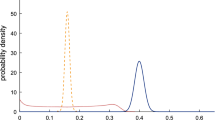Abstract
A contamination technique is presented as a numerically tractable tool to post-optimization and analysis of robustness of the optimal value of scenario-based stochastic programs and of the expected value problems. Detailed applications of the method concern the two-stage stochastic linear programs with random recourse and the corresponding robust optimization problems.
Similar content being viewed by others
References
J.R. Birge, The value of the stochastic solution in stochastic linear programs with fixed recourse, Mathematical Programming 24, 1982, 314–325.
W. Bühler, Capital budgeting under qualitative data information, inCapital Budgeting under Conditions of Uncertainty, R.L. Crum and F.G.J. Derkinderen, eds., M. Nijhoff, Boston, 1981, pp. 81–117.
R.S. Dembo, Scenario optimization, Annals of Operations Research 30, 1991, 63–80.
M.A.H. Dempster and A.M. Ireland, A financial expert decision system, inMathematical Models for Decision Support, G. Mitra, ed., NATO ASI Ser. Vol. 48, Springer, Berlin, 1988, pp. 415–440.
J. Dupačová, Stability in stochastic programming with recourse. Contaminated distributions, Mathematical Programming Study 27, 1986, 133–144.
J. Dupačová, Stability and sensitivity analysis for stochastic programming, Annals of Operations Research 27, 1990, 115–142.
J. Dupačová, Postoptimality for multistage stochastic programs, Annals of Operations Research 56, 1995, 65–78.
J. Dupačová, Analysis of the expected value solution and the worst case analysis under relaxed convexity assumptions, Paper presented atMinisymposium on Stochastic Programming, Berlin, Jan. 22–23, 1994.
Yu. Ermoliev, Stochastic quasigradient methods and their application to systems optimization, Stochastics 9, 1983, 1–36.
E.G. Gol'shtein,Theory of Convex Programming, Translations of Mathematical Monographs 36, American Mathematical Society, Providence, RI, 1972.
B. Golub et al., A stochastic programming model for money management, RR 93-01-01, Hermes Laboratory, Wharton, Philadelphia, 1992; to appear in European Journal of Operations Research.
J. Gondzio and A. Ruszczyński, Sensitivity method for basis inverse representation in multistage stochastic linear programming problems, JOTA 74, 1992, 221–242.
F.R. Hampel, The influence curve and its role in robust estimation, Journal of the American Statistical Association 69, 1974, 383–397.
J.L. Higle and S. Sen, Stochastic decomposition: An algorithm for two-stage linear programs with recourse, Mathematics of Operations Research 16, 1991, 650–669.
A.J. King et al., Lake eurotrophication management: The Lake Balaton project, inNumerical Techniques of Stochastic Optimization, Yu. Ermoliev and R.J-B Wets, eds., Springer, Berlin, 1988, pp. 435–444.
A.J. King and D.J. Jensen, Linear-quadratic efficient frontiers for portfolio optimization, Appl. Stoch. Models Data Anal. 8, 1992, 195–208.
M.I. Kusy and W.T. Ziemba, A bank asset and liability management model, Operations Research 34, 1986, 356–376.
J.M. Mulvey, Robust optimization on PC supercomputers, SIAM News 26, 1993, No. 7.
J.M. Mulvey et al., Robust optimization of large scale systems, Operations Research 43, 1995, 264–281.
S.M. Robinson and R.J-B Wets, Stability in two-stage stochastic programming, SIAM Journal on Control and Optimization 25, 1987, 1409–1416.
J.K. Sengupta, Robust solutions in stochastic programming, J. Oper. Res. Soc. 42, 1991, 857–870.
R.J-B Wets, The aggregation principle in scenario analysis and stochastic optimization, inAlgorithms and Model Formulations in Mathematical Programming, S.W. Wallace, ed., Springer, Berlin, 1989, pp. 91–113.
S.A. Zenios, Massively parallel computations for financial planning under uncertainty, inVery Large Scale Computing in the 21st Century, J. Mesirov, ed., SIAM, Philadelphia, 1991, pp. 273–294.
Author information
Authors and Affiliations
Additional information
This work was supported by the Grant Agency of the Czech Republic under Grant No. 402/93/0631.
Rights and permissions
About this article
Cite this article
Dupačová, J. Scenario-based stochastic programs: Resistance with respect to sample. Ann Oper Res 64, 21–38 (1996). https://doi.org/10.1007/BF02187639
Issue Date:
DOI: https://doi.org/10.1007/BF02187639




